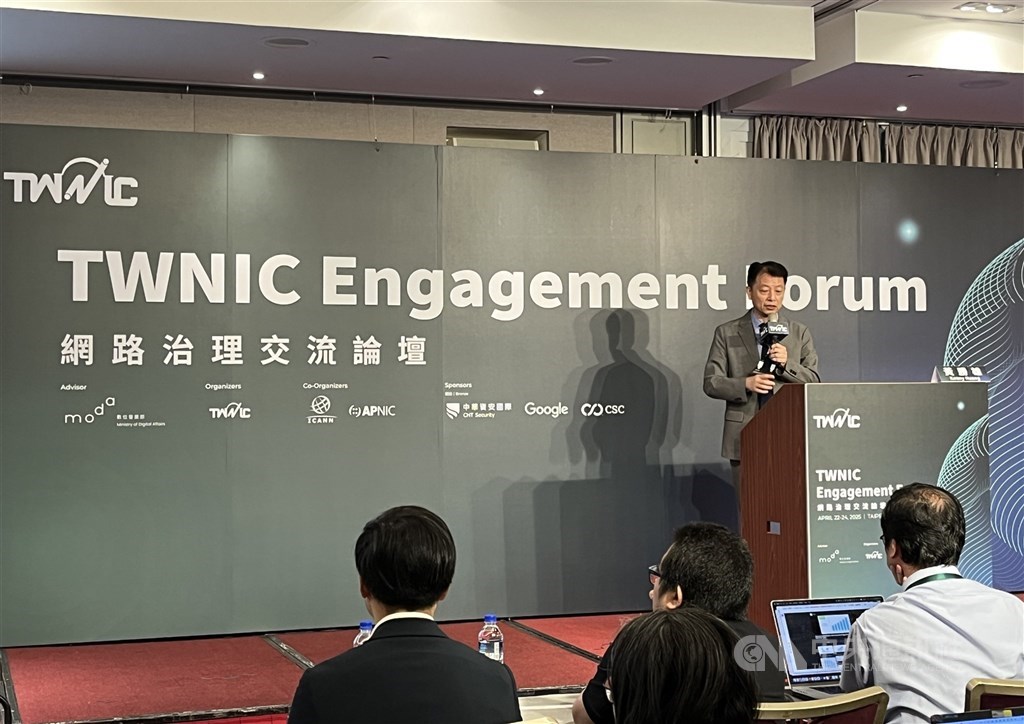Taipei, April 23 (CNA) Taiwan needs to streamline the application process for new undersea cables to “encourage more investment,” while also prioritizing the protection of critical underwater infrastructure against China’s “gray zone” threats, the head of the Taiwan Network Information Center (TWNIC) said Wednesday.
In his keynote speech at the TWNIC Engagement Forum in Taipei, TWNIC Chairman Kenny Huang (黃勝雄)said that Taiwan “currently has only 14 [international] submarine cables, with one or two more in the pipeline — but can we encourage more investment for submarine cables?”
In a previous interview with CNA, Huang described Taiwan’s 14 international and 10 domestic undersea communication cables — which carry 99 percent of the country’s internet traffic — as a “digital lifeline.”
While the international cables are mostly built through joint ventures involving multiple global companies, all domestic cables are owned and operated by Chunghwa Telecom, Taiwan’s largest telecom service provider, according to the Ministry of Digital Affairs, which oversees the nonprofit organization TWNIC.
Huang said there are “a lot of processes” involved in applying to set up a new undersea cable, whether by international or domestic companies, with approval required from multiple government agencies, including the National Communications Commission, the Ministry of the Interior, and even the Ministry of Culture (MOC).
A presentation slide shown by Huang indicated that the approval process for an application to conduct an underwater cultural heritage survey takes around eight months at the MOC, while approval of the completed report can take up to 12 months.
The same slide also showed that Taiwan’s application for permits to system inspection takes an average of 29 months, more than double the Asia-Pacific regional average of 14 months.
“The review process includes many unnecessary steps,” Huang said, citing the example of the underwater cultural heritage survey, which he suggested could instead be submitted only if underwater heritage is actually discovered, a practice adopted by other countries in the region, such as Japan, the Philippines, and Australia.
Huang also touched on the protection of critical underwater infrastructure (CUI), which includes power cables, oil pipelines, and undersea communication cables, spanning from Taiwan’s 12-nautical-mile territorial waters to its 200-nautical-mile exclusive economic zone (EEZ), and further into the high seas.
Huang said “new capabilities” are needed, as the underwater domain is a natural theater for “gray zone” actions.
“One moment, nothing seems to be happening, and the next, the entire cable is gone — and you wouldn’t even see it happen,” Huang said. “There are too many vehicles and tools capable of carrying out such an operation, including unmanned vehicles and uncrewed vessels,” he added.
He said a full digital model of the exclusive economic zone (EEZ) based on sonar imaging could be used to monitor the undersea domain, “because underwater, the only available tool is sonar.”
The model could be developed based on Taiwan’s territorial waters if costs are a concern, Huang added.
Asked by CNA whether Taiwan can currently defend its CUI, Huang said that the government should develop a national strategy to protect CUI, with priorities set according to available resources.
Taiwan has experienced several incidents in recent years where its undersea communication cables were either damaged by natural causes or deliberately cut, temporarily disrupting internet connectivity.
Local authorities have characterized some of these incidents as Chinese “gray zone” tactics, referring to provocative or aggressive actions that fall short of open conflict.
Earlier this month, Tainan prosecutors indicted the Chinese captain of a Togolese-registered vessel suspected of deliberately severing an undersea communication cable linking Taiwan and Penghu in late February.
